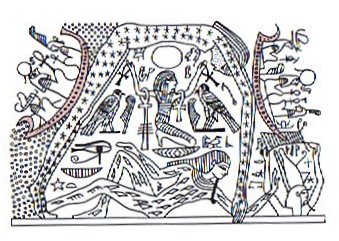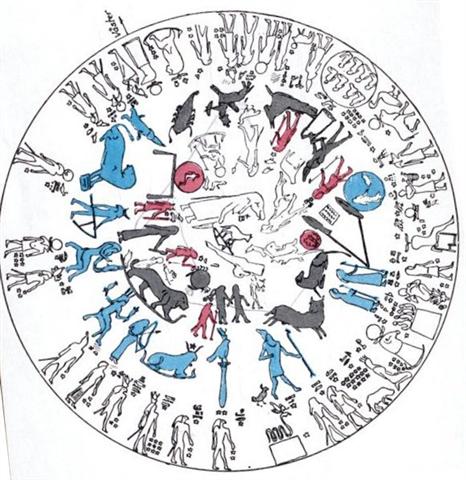2. We enlightened citizens in the west have 'frozen time' so that in our astrology e.g. Virgo is thought to begin on August 23 instead of where she now really is according to the observed stars (September 16). The seagoing Polynesians must have had a better judgment:. ... Far away, the Mangaians of old (Austral Islands, Polynesia) ... kept the precessional clock running instead of switching over to 'signs' ... Yet, they certainly would have kept their old memories alive as to where the sky roof 'originally' had been positioned, with Gemini at spring equinox (north of the equator), with Virgo at summer solstice, and with Scorpio at the end of summer. Precession was common knowledge, because they observed how the position of the sky roof changed with about one day (degree) every 360 / 5 = 72 years. From this and the stable configurations of the stars it was easy to see where the sky roof earlier had been. If the G text was intended to preserve astronomical knowledge, then these stable star configurations ought to have been used primarily not to document them but to use them as reference points in order to make the text readable also for someone who was not familiar with it. The location of Ana-roto at glyph number 100 followed by Ana-mua 46 positions later could therefore have been intended to quickly make a new reader guess the structure, and by finding Ana-muri a further 184 days ahead he would receive confirmation:
Any remaining doubts would disappear after having counted the number of glyphs on side a and side b, and related them to the lunar synodic cycle of 16 * 29½ = 472 days. Each glyph must stand for 1 day and the odd number of glyphs on side a (229) requires an addition, similar to how 29 needs a fraction to reach the correct number of nights in a month and to how 360 needs 5 days more to reach the number of whole days in a year. Although the number of glyphs on the tablet are only 471 (= 1½ * 314), there are 230 glyphs from Ga4-16 to Gb4-9:
By fixing Ana-roto at position 100 (or 99 if the glyphs are counted from Ga1-1) the text could, furthermore, be a statement of where the sky roof currently was located according to Sun. 100 days is equal to 400 rectascension minutes (given cycles of 360 days respectively 24 hours) and 400m = 6h 40m. According to my basic astronomy book Spica is at 13h 23m, counted from spring equinox north of the equator. If we instead count from winter solstice south of the equator there will be an adjustment with 172 - 80 = 92 days:
13h 23m corresponds to 13 * 60 + 23 = 803m = 803 / 4 = 200¾ days, i.e. north of the equator Spica is positioned ca 200 days after spring equinox. South of the equator it means ca 200 days after autumn equinox. If we count from the beginning of the year, we must add 266 days in which case we will reach day number 200 + 266 - 365 = 101. If we count from winter solstice we need to add a further 365 - 358 = 7 days:
To reach 100 (as in glyph number 100) we can calculate with the effect of precession and an origin for the G text about 8¾ * 72 = 630 ago, a time prior to the arrival of the Europeans. 100 days is 8 days (similar to the time when Venus is absent from the sky) more than 92, which happens to be equal to 358 - 266:
Beyond autumn equinox Moon rules alone until Sun is 'reincarnated', and Moon should be counted as 2 (in contrast to the singular Sun) - she has 2 faces and she carries the future Sun king in her belly. If Spica is the star where Sun is regenerated, then Ana-roto could once have been positioned at day 92 + 8 = 100 counted from autumn equinox, at the end of winter solstice. Such would have been the case ca 72 * 108¾ = 7,800 years ago, when Gemini stood guards at autumn equinox, at the entrance to the Underworld:
46 days from Ana-roto to Ana-mua could symbolize how a new Sun now exists (though still not powerful enough to make himself felt very much). At Spica the measure changed from 2 * 46 = 92 to a single 46. If we leave such ideas - based on astrology and my imagination - and instead look at reality as it should have been perceived a few hundred years ago (when the G text could have been created) it can be objected that Ana-roto was not 100 days but ca 200 days after autumn equinox (in other words around day number 266 + 200 = 466 or ca 100 days into the new year). There are 471 glyphs on the G tablet, or about 100 more than necessary to cover 365 days. And the glyphs evidently tell about the end of Sun around vaha kai in Gb5-10:
7 figures are looking ahead and they are not depicted en face. Maybe it means winter solstice lies ahead and that another quarter must be added to reach the end of it - in other words that glyph number 366 (presumably Hanga Te Pau) stands at day number 266 = autumn equinox. If Ana-roto is at glyph number 100 and if spring is beginning with her, then Hanga Te Pau (glyph number 366) could be at autumn equinox:
260 = 13 * 20 seems to have been an ancient measure for Sun. If we define its end as autumn equinox, then its beginning could be 260 + 6 extra days earlier. The cycle of the year is longer, though, and another ca 100 days could be assigned for the period of 'pregnancy' before Moon delivers Sun. Thus, the text on the front side of the G tablet possibly is beginning ca 100 days beyond autumn equinox and at the end of winter solstice. With autumn equinox at Gb5-12 there are ca 200 glyphs to Ana-roto, and we need to count each day as 2 glyphs in order to make it fit. Moon should be counted as 2 and if she instead of Sun rules beyond autumn equinox, then these 200 glyphs could correspond to 100 days. A less imaginative solution is simply to say that beyond Gb5-12 there is a jump in time across a gap corresponding to the remaining glyphs on side b before the next Sun year will begin anew. Spica basically means a 'spike' or a 'point' and with this 'spear' the dark cloth of winter is rended apart, an idea which possibly can explain why in spring the prow of the Sun ship is piercing the 'cloth' held high:
Or it could be a Field:
Notably there is a similar drawing around autumn equinox, Abyss. "... Behind the goddess and child is the strange figure of a bull-headed man holding a hoe-like implement. He stands in front of a rectangle decorated with wavy lines – very similar to the rectangle located between the Piscean fish. It is very likely that this figure is based on the Babylonian constellation known as the Harrow. It is described in star texts as ‘the weapon of the god Mar-biti’ and that within it is seen a representation of the Abyss - the reservoir of fresh-water found beneath the earth. We have already seen that the rectangle infilled with wavy lines symbolises the watery Abyss in Mesopotamian art. Once again the Dendera imagery and Babylonian star-lore, even though difficult to understand in isolation, throw considerable light on each other when combined. The penultimate figure of this sequence is sometimes described as a lion-like creature, which has its front feet resting on the Abyss symbol. Judging by the surrounding constellations it is very likely to be located in the region of Centaurus ..."
Maybe a hole to the Underworld should be filled with sweet water. Earlier Ana-mua had a lower rectascension and once it could (south of the equator) have been 'the prow of the Sun ship', which when on the horizon would tell the world about the new 'land' coming near: ... On the twenty-fifth day of the first month (Vaitu Nui), Ira and Makoi set sail; on the first day of June ('Maro'), the bow of Ira's canoe appeared on the distant horizon, came closer and closer on its course, and sailed along, and finally (one) could see the (new home) land ... North of the equator Virgo stands at the other end of the year, where the watery autumn hole will swallow Sun. It is difficult to understand the name 'spike' unless a position south of the equator is assumed. But when precession moved Spica into the position where earlier Antares had stood, the idea of a pointed prow could have been transferred to it from the pointed sting of Scorpio. And in between Arcturus could have inherited the position and function of 'spring announcer':
The 'middle' pillar is primarily not indicating the center position of the Sun ship, I think. Instead it could refer to the interval between the Old Sun (Rei Muri) and the New Sun (Rei Mua), the interregnum between the years. Once this period had been quite short, but with precession it grew out of all proportions, with 1 additional day each 72 years. |
|||||||||||||||||||||||||||||||||||||||||||||||||||||||||||||||||||||||||||||||||||||||||||||||||||||||||||||||||||||||||||||||||||||||||||||||||||||||||||||||||||||||||||||||||||||









